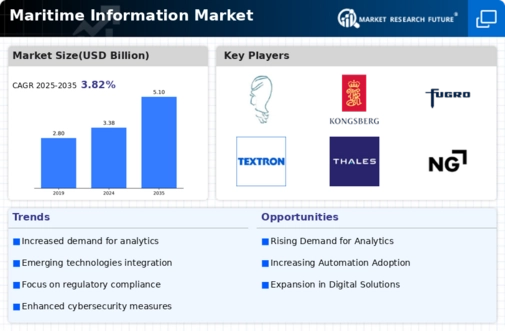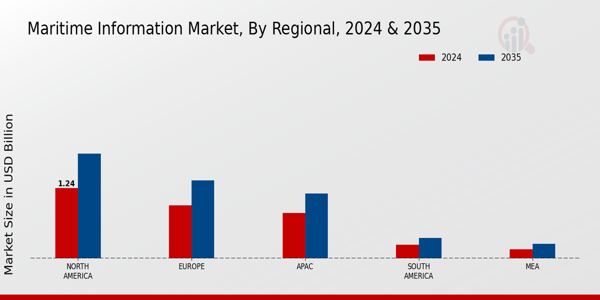Regulatory Compliance
Regulatory compliance is a crucial driver for the Global Maritime Information Market Industry, as governments worldwide enforce stricter maritime regulations. Initiatives aimed at enhancing safety, environmental protection, and security are compelling shipping companies to adopt advanced maritime information systems. For example, the International Maritime Organization has implemented regulations that require real-time data reporting for vessel emissions. This regulatory landscape is expected to propel the market towards a valuation of 5.1 USD Billion by 2035, as companies invest in compliance technologies to meet these standards.
Growing Trade Activities
The increase in global trade activities significantly influences the Global Maritime Information Market Industry. As international trade expands, the demand for efficient maritime logistics and information systems rises. The World Trade Organization reports a steady growth in global merchandise trade, which necessitates improved shipping routes and logistics management. Consequently, maritime information systems that provide real-time data on shipping schedules and port conditions are becoming indispensable. This trend is likely to sustain a compound annual growth rate of 3.81% from 2025 to 2035, further driving market growth.
Market Growth Projections
The Global Maritime Information Market Industry is projected to grow significantly, with estimates indicating a market value of 3.38 USD Billion in 2024 and a potential increase to 5.1 USD Billion by 2035. This growth trajectory suggests a compound annual growth rate of 3.81% from 2025 to 2035. Such projections reflect the increasing reliance on maritime information systems to enhance operational efficiency, safety, and compliance within the maritime sector. The market's expansion is likely driven by technological advancements, regulatory pressures, and the growing need for sustainable practices in maritime operations.
Technological Advancements
The Global Maritime Information Market Industry is experiencing a surge in technological advancements, particularly in satellite communication and data analytics. Innovations such as real-time tracking and predictive analytics enhance operational efficiency and safety. For instance, the integration of IoT devices on vessels allows for continuous monitoring of ship conditions, which can lead to reduced maintenance costs and improved safety protocols. As a result, the market is projected to reach 3.38 USD Billion in 2024, reflecting the growing reliance on technology to optimize maritime operations.
Increased Cybersecurity Threats
The rise in cybersecurity threats poses a significant challenge to the Global Maritime Information Market Industry, driving the need for robust security measures. As maritime operations become more digitized, the risk of cyberattacks on shipping systems and data networks increases. This has led to a heightened focus on cybersecurity solutions within the maritime sector. Companies are investing in advanced information systems that incorporate cybersecurity protocols to protect sensitive data and ensure operational continuity. This trend underscores the importance of cybersecurity in maritime information systems, potentially influencing market dynamics.
Environmental Sustainability Initiatives
Environmental sustainability initiatives are shaping the Global Maritime Information Market Industry as stakeholders increasingly prioritize eco-friendly practices. The maritime sector is under pressure to reduce its carbon footprint, leading to the adoption of green technologies and sustainable shipping practices. For instance, the International Maritime Organization has set ambitious targets for reducing greenhouse gas emissions from ships. This shift towards sustainability is prompting investments in maritime information systems that facilitate compliance with environmental regulations and enhance operational efficiency, thereby contributing to the market's growth.



















Leave a Comment